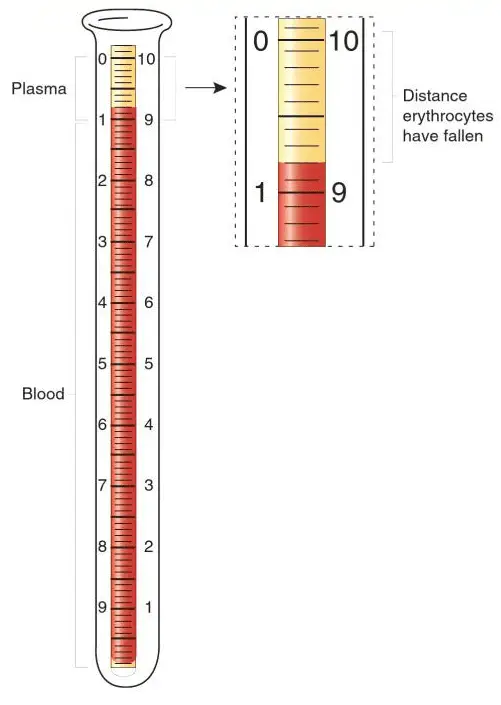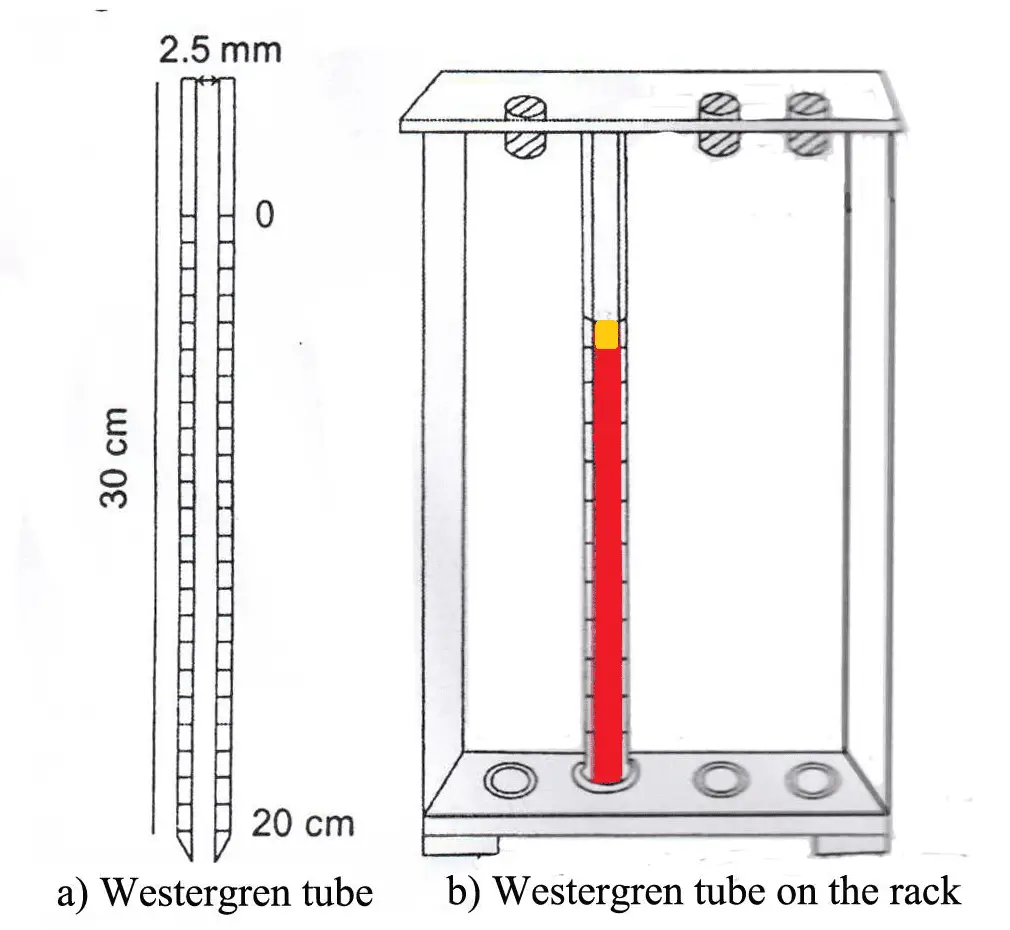The erythrocyte sedimentation rate (ESR) is a common hematological test for nonspecific detection of inflammation that may be caused by infection, some cancers and certain autoimmune diseases. It can be defined as the rate at which Red Blood Cells (RBCs) sediment in a period of one hour.
Principle of ESR
When anticoagulated blood is allowed to stand in a narrow vertical glass tube, undisturbed for a period of time, the RBCs – under the influence of gravity- settle out from the plasma. The rate at which they settle is measured as the number of millimeters of clear plasma present at the top of the column after one hour(mm/hr). This mechanism involves three stages:
- Stage of aggregation : It is the initial stage in which piling up of RBCs takes place. The phenomenon is known as Rouleaux formation. It occurs in the first 10-15 minutes.
- Stage of sedimentation : It is the stage of actual falling of RBCs in which sedimentation occurs at constant rate. This occurs in 30-40 minutes out of 1 hour, depending upon the length of the tube used.
- Stage of packing : This is the final stage and is also known as stationary phase. In this, there is a slower rate of falling during which packing of sedimented RBCs in column occurs due to overcrowding. It occurs in final 10 minutes in 1 hour.
Methods of ESR determination
There are two main methods to determine ESR :
- Wintrobe’s method
- Westergren’s method
Each method produces slightly different results. Mosely and Bull (1991) concluded that Wintrobe’s method is more sensitive when the ESR is low, whereas, when the ESR is high, the Westergren’s method is preferably an indication of patient’s clinical state.
Wintrobe’s method

This method uses Wintrobe’s tube, a narrow glass tube closed at the lower end only. The Wintrobe’s tube has a length of 11 cm and internal diameter of 2.5 mm.
It contains 0.7-1 ml of blood. The lower 10 cm are in cm and mm. The marking is 0 at the top and 10 at the bottom for ESR.
This tube can also be used for PCV. The marking is 10 at the top and 0 at the bottom for PCV.
Requirements :
- Anticoagulated blood (EDTA, double oxalate)
- Pasteur pipette
- Timer
- Wintrobe’s tube
- Wintrobe’s stand
Procedure:
- Mix the anticoagulated blood thoroughly.
- By using Pasteur pipette, fill the Wintrobe’s tube upto ‘0’ mark. There should be no bubbles in the blood.
- Place the tube vertically in ESR stand and leave undisturbed for 1 hour.
- At the end of 1 hour, read the result.
Normal values :
For males : 0-9 mm/hr
For females 0-20 mm/hr
Westergren’s method
It is better method than Wintrobe’s method. The reading obtain is magnified as the column is lengtheir. The Westregren tube is open at both ends. It is 30 cm in length and 2.5 mm in diameter. The lower 20 cm are marked with 0 at the top and 200 at the buttom. It contains about 2 ml of blood.

Requirements :
- Anticoagulated blood (0.4 ml of 3.13% trisodium citrate solution + 1.6 ml blood)
- Westergren tube
- Westergren stand
- Rubber bulb (sucker)
Procedure :
- Mix the anticoagulated blood thoroughly.
- Draw the blood into the tube upto 0 mark with the help of rubber bulb.
- Wipe out blood from bottom of the tube with cotton.
- Set the tube upright in stand. Make sure the pipette fits snugly to eliminate possible leakage and that the pipette is in vertical position.
- Leave the tube undisturbed for 1 hour.
- At the end of 1 hour, read the result.
Normal values
For males : 0-10 mm/hr
For females : 0-15 mm/hr
Clinical Significance of ESR
The erythrocyte sedimentation rate (ESR) is a non-specific test. It is raised in a wide range of infectious, inflammatory, degenerative, and malignant conditions associated with changes in plasma proteins, particularly increases in fibrinogen, immunoglobulins, and C-reactive protein.
The ESR is also affected by many other factors including anaemia, pregnancy, haemoglobinopathies, haemoconcentration and treatment with anti-inflammatory drugs.
Causes of a significantly raised ESR :
- All types of anemias except sickle cell anemia
- Acute and chronic inflammatory conditions and infections including:
– HIV disease
– Tuberculosis
– Acute viral hepatitis
– Arthritis
– Bacterial endocarditis
– Pelvic inflammatory disease
– Ruptured ectopic pregnancy
– Systemic lupus erythematosus - African trypanosomiasis (rises rapidly)
- Visceral leishmaniasis
- Myelomatosis, lymphoma, Hodgkins disease, some tumours
- Drugs, including oral contraceptives
Causes of Reduced ESR :
- Polycythaemia
- Poikilocytosis
- Newborn infants
- Dehydration
- Dengue haemorrhagic fever
- Other conditions associated with haemoconcentration

Good
Dear Author, can you just share with us,now a days automated esr anylzers are avilable, sone are giving resultsin 20 seconds, which is ideal and precise automated or 1 hour western method. Pl guide us
Dear Girish,
Most automated ESR analyzers measure the Zeta potential of blood cells (by impedance) which is the net charge on their surfaces in an electric field, hence their tendency to the resist each other during rouleaux formation; this is affected by their population and consistency of the cells expressed as a factor of g (which is constant).
Very good thankyou very much.
Hello Giri
Thanks for your very detailed article. I am referencing this article to one of my lessons on ESR Test. I also like to reference the image of Westerngren tube in your article.
Its good and l for …usefull for MLT professionals like us
Excellent articles
If I have no sucker bulb than I can suck with mouth. So my question is that what side effect of e.s.r sucking with mouth…?
45 is the value that comes out from my ESR (WG/WINTROBE).Is this normal or not? What should I have done?
hello giri, you have really try, may God bless you. I am referencing your article,for my IT report.
thank you very much!! it was very good lessons
Clear information regarding ESR….good one
thanks Giri I am refence to your knowledge
This is an extremely good blog.. covering every necessary topics.. thanku
It has been intresting thank u
Sir,
My ESR is showing at 50mms in first hr and 95 mms in 2nd hr. What does it indicate? how to treat this to bring it low
sahi xa
So accurate
Very good article.
excellent thanks so much
I’m student so it’s very useful for me
nice
is it the PRINCIPLE of the test using above method and analyzer method are the same.
Hii Rahul here I m talking about my father age 58 yrs & ESR is 29 by Westgrens method what may be the probable reason .plz guide me ..thanx
wow tanks I really learned a lot from this
thanks so much.
iam student so it’s very useful for me